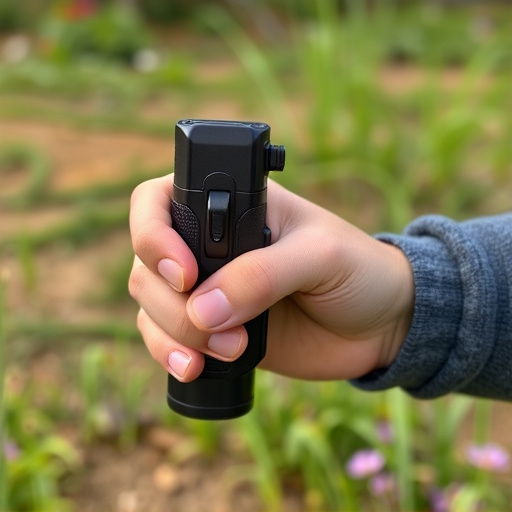Riot control spray, or pepper spray, is a non-lethal tool used to disperse crowds during civil unrest, employing chemicals that cause temporary disability. The "Spray and Move" technique involves quick bursts of spray directed at crowd perimeters or agitators, allowing for swift control without prolonged harm. Safety training is crucial for law enforcement using these canisters, focusing on risk understanding, decontamination, storage, disposal, and deployment techniques like Spray and Move to minimize bystander and officer harm. Globally, the legal status and regulation of riot control spray vary, with ethical considerations emphasizing de-escalation and proportional force.
Riot control inflammatory spray canisters have become a ubiquitous tool in law enforcement, employed during civil unrest and high-risk situations. This article delves into the intricate world of these powerful tools, exploring their composition, effects, and safety measures. We discuss effective spray and move deployment techniques for optimal control, along with legal considerations and ethical use guidelines. Understanding these aspects is crucial for law enforcement agencies aiming to manage chaotic scenarios efficiently while ensuring public safety.
- Understanding Riot Control Spray Canisters: Their Composition and Effects
- Effective Spray and Move Deployment Strategies for Law Enforcement
- Safety Measures and Training Required for Handling Inflammatory Spray
- Legal Considerations and Ethical Use of Riot Control Spray Canisters
Understanding Riot Control Spray Canisters: Their Composition and Effects
Riot control spray canisters, also known as pepper spray or tear gas canisters, are non-lethal weapons designed to disrupt and disperse crowds during civil unrest, protests, or other high-tension situations. These canisters contain a range of chemicals, typically capsaicin (the active ingredient in chili peppers) or chloroacetonitrile, which when sprayed, cause temporary yet intense irritation to the eyes, nose, throat, and lungs. This sensory overload helps to break up large gatherings quickly and safely.
The deployment techniques for these spray canisters involve strategic spraying patterns designed to maximize coverage while minimizing off-target effects. Police and security forces often employ “spray and move” tactics, where a quick burst of the spray is directed at the crowd’s perimeter or specific individuals identified as agitators, allowing for swift control of the situation without causing prolonged harm. Effective use requires proper training and adherence to safety protocols to ensure both public and officer safety.
Effective Spray and Move Deployment Strategies for Law Enforcement
In riot control situations, effective deployment of inflammatory spray canisters is crucial for law enforcement agencies. The successful use of these devices involves strategic Spray and Move Deployment Techniques. One key strategy is to target specific individuals or groups within a crowd, aiming to disrupt their formation while minimizing collateral damage. This tactic requires precise timing and coordination among officers.
By employing swift and calculated movements, law enforcement can create separation between rioters, allowing for easier control and de-escalation. The Spray and Move approach ensures that the inflammatory spray is used as a tool for crowd management rather than a primary means of suppression. It enables officers to quickly move through crowds, using the canister’s range and effect to their advantage while maintaining safety and minimizing harm.
Safety Measures and Training Required for Handling Inflammatory Spray
When handling inflammatory spray canisters, safety is paramount. Law enforcement officers and riot control personnel must undergo rigorous training to ensure they understand the risks associated with these powerful tools. This includes learning appropriate decontamination procedures after use, as well as how to safely store and dispose of the cans. Training should cover both theoretical knowledge and practical application, focusing on spray and move deployment techniques to maximize effectiveness while minimizing harm to bystanders and officers alike.
Regular practice sessions are crucial in honing skills and fostering a culture of safety. Officers must be adept at assessing the situation, selecting the right canister for the job, and employing the correct technique to control riots or hazardous situations. The training should also address the importance of maintaining a safe distance, using protective gear, and being aware of wind conditions that could affect the spray’s trajectory, ensuring both public safety and the accountability of the officers in their actions.
Legal Considerations and Ethical Use of Riot Control Spray Canisters
The legal landscape surrounding riot control spray canisters varies significantly across jurisdictions, reflecting diverse societal perspectives on public safety, civil liberties, and law enforcement practices. In many countries, these devices are legally classified as weapons, subject to strict regulations governing their manufacture, sale, and use. Authorities typically mandate that police officers undergo specialized training in spray and move deployment techniques to ensure responsible and proportional application during crowd control scenarios. Non-lethal weapons like riot control spray are designed to incapacitate temporarily without causing permanent harm, but their potential for misuse raises ethical concerns.
The ethical use of riot control spray emphasizes the importance of de-escalation strategies and proportionate force. Law enforcement agencies must ensure that officers employ these canisters only as a last resort when other non-lethal means have failed, and in situations where the risk to public safety justifies their use. Transparent policies and oversight mechanisms are crucial for accountability, preventing abuse, and fostering public trust. Spray and move deployment techniques should prioritize minimizing harm, protecting both officers and civilians, and upholding the rule of law.
Riot control spray canisters, with their powerful inflammatory properties, serve as a critical tool for law enforcement in managing civil unrest. Understanding their composition, effects, and proper deployment strategies, such as the effective use of Spray and Move techniques, is essential for ensuring public safety. Comprehensive training on handling these canisters, along with strict adherence to legal guidelines and ethical considerations, is paramount to prevent misuse and protect both officers and civilians. By striking a balance between maintaining order and upholding human rights, law enforcement agencies can leverage these tools responsibly in mitigating chaotic situations.
